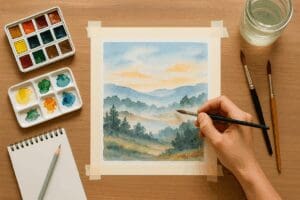Exploring the Palette Knife: Unlocking Bold and Expressive Textures in Painting
Introduction
In the world of painting, textures play a pivotal role in adding depth, emotion, and dimension to a piece. While brushes are a classic tool in every artist’s repertoire, the palette knife stands as a powerful instrument for creating bold, dynamic textures that captivate the eye. The palette knife offers a unique approach to painting, allowing artists to explore impasto techniques, add expressive strokes, and build vibrant, tactile surfaces that breathe life into their work. This blog post delves into the various ways the palette knife can be used to transform an artwork, particularly in acrylic and oil painting. By the end of this article, you’ll not only understand the palette knife’s potential but also be equipped with practical techniques to experiment with this exciting tool.
What is a Palette Knife?
Before we delve into the techniques, it’s important to first understand the tool itself. A palette knife is a flat, blunt tool with a metal blade that comes in various shapes and sizes, typically with a handle made of wood or plastic. Though originally designed for mixing paint on a palette, the palette knife has evolved into an essential painting tool. Its flexible blade allows artists to apply paint with precision and versatility, enabling the creation of textures and effects that would be difficult to achieve with a traditional brush.
Artists may use the palette knife for a variety of tasks, from mixing and applying paint to creating rich, textured surfaces. It is especially favored for its ability to achieve impasto effects—thick, textured layers of paint that give a sense of movement and energy to a painting. Whether working with acrylics or oils, the palette knife provides an avenue for exploring bold expressions through paint.
The Palette Knife’s Role in Acrylic and Oil Painting
When using a palette knife, artists can achieve different textures depending on the medium they’re working with. Acrylics and oils each present unique challenges and benefits when it comes to palette knife techniques.
Acrylics: Quick Drying and Versatile
Acrylic paint is fast-drying, which can initially seem like a disadvantage for palette knife work, especially when trying to blend or build up thick layers. However, this characteristic can also be an advantage, allowing the artist to work quickly and layer paint without long waits for drying.
-
Techniques in Acrylics:
-
Impasto: By applying acrylic paint thickly with a palette knife, you can create dramatic textures that give your artwork a sense of physicality. The beauty of impasto is in the way the light interacts with the raised surfaces, creating dynamic shadows and highlights.
-
Scraping and Sgraffito: You can use a palette knife to scrape through layers of paint, revealing underlayers and creating interesting contrasts. This technique, known as sgraffito, can also work with acrylics to carve textures or lines into a painted surface.
-
Textured Backgrounds: Use the palette knife to apply acrylics in a variety of ways—thin layers for subtle textures or thick, exaggerated strokes to create a dramatic, almost sculptural effect.
-
Oils: Slow Drying and Rich Textures
Oil paints, with their longer drying times, provide a different set of opportunities for palette knife use. They allow for extended working time, making it easier to manipulate the paint and achieve seamless blending or textured layers.
-
Techniques in Oils:
-
Palette Knife Landscapes: Oils lend themselves beautifully to creating expressive landscapes with palette knives. The tool can be used to lay down broad, sweeping strokes for skies or thick, heavy impasto for creating textured, tactile elements like rocks, foliage, and mountains.
-
Bold, Layered Surfaces: The slow drying nature of oils allows artists to build up thick layers over time, adding to the textured effect. Oil paint’s rich consistency is perfect for creating a dramatic, painterly surface that can be further manipulated with the palette knife for depth and texture.
-
Mixing and Blending: The palette knife can also be used to mix colors directly on the canvas, creating beautiful, unexpected blends and transitions that are distinct from brushwork.
-
Techniques for Using a Palette Knife in Painting
Let’s explore some specific techniques that artists can use when working with a palette knife, whether in acrylic or oil.
1. The Basic Strokes
Mastering a few simple strokes with the palette knife is a great starting point for beginners. Once you get comfortable with these basic techniques, you’ll be able to experiment and develop your own style.
-
Flat Stroke: Hold the knife with the flat edge parallel to the surface, and use long, sweeping strokes to apply thick paint. This creates a smooth, wide texture and is ideal for covering large areas.
-
Scumbling: Scrape a small amount of paint onto the knife and use quick, short movements to apply a textured, broken effect on the canvas. Scumbling can add a layer of complexity and depth, especially in background areas.
-
Stippling: Use the tip of the palette knife to apply small, controlled dabs of paint. This is ideal for creating fine details, such as the texture of tree bark or rough surfaces.
2. Impasto Technique
One of the most exciting aspects of using a palette knife is the ability to create impasto effects—thick, expressive layers of paint. This technique is often used in both oil and acrylic painting to add a sculptural quality to a piece.
-
Building Layers: Apply paint in heavy, deliberate strokes, building up the paint in thick layers. This can be done with a single color or multiple hues, creating rich textures and color contrasts.
-
Dynamic Effects: Because of the thickness of the paint, impasto creates dynamic, tactile surfaces. Light and shadow will interact with the raised surfaces, giving your work a three-dimensional quality.
-
Color Blending: When using impasto with oils, you can mix colors directly on the surface, letting them blend naturally as you lay down the paint with the palette knife. In acrylics, you’ll need to work a bit faster since the paint dries quickly.
3. Textured Backgrounds
Palette knives are ideal for creating textured backgrounds that support the main subject of your painting. You can apply a variety of techniques, such as building up thick layers in some areas while leaving others smooth. This allows the painting to have a sense of depth and movement without overwhelming the focal point.
-
Thick and Thin Layers: Apply thick layers in areas where you want to create depth or focus, and use thinner layers in the background or surrounding areas.
-
Use of Impasto and Scraping: You can experiment with scraping off some of the top layers of paint to reveal the underpainting, creating a sense of texture and history within the piece.
Tips for Working with a Palette Knife
-
Choose the Right Palette Knife: Experiment with different shapes and sizes of palette knives to find the one that feels right for your technique. Some knives are better for broad strokes, while others excel at fine details.
-
Mind the Paint’s Consistency: The thicker the paint, the more texture you can create. If you’re working with oils, you can use mediums like linseed oil or impasto gel to thicken the paint. In acrylics, consider using modeling paste or heavy body acrylics for impasto effects.
-
Don’t Overwork the Paint: Palette knife work is often most effective when you don’t overdo it. Let the natural texture of the paint and the knife strokes create the movement and energy in the piece.
-
Clean Your Knife Regularly: Acrylics can dry quickly, so make sure to clean your knife regularly to avoid unwanted buildup. Oils, on the other hand, stay workable for longer, but it’s still a good idea to keep the knife clean to prevent colors from becoming muddy.
Conclusion
The palette knife is an invaluable tool for any artist looking to explore the world of texture in their work. Whether you’re an acrylic artist wanting to add dynamic layers or an oil painter seeking to create bold, sculptural surfaces, the palette knife offers endless possibilities. By mastering techniques such as impasto, scraping, and texturing, you can bring your paintings to life with depth and emotion.
So, grab your palette knife and start experimenting! Whether you’re new to this tool or looking to enhance your skills, the texture-rich world of palette knife painting is waiting for you.
*For collaborations, art features, or inquiries, please contact us at [email protected]. Don’t forget to follow us on Instagram, Facebook, Twitter.
Disclaimer: The views and opinions expressed in this article do not necessarily reflect the official policy or position of Irish Artmart.
Irish Artmart – Your Gateway to Artistic Excellence.
Image by Steve Johnson from Pixabay




